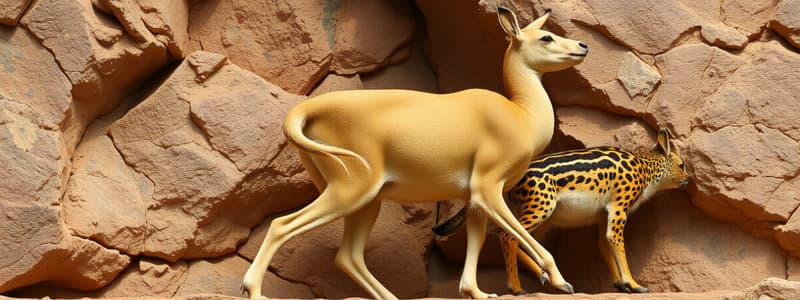Podcast
Questions and Answers
What does the 'Law' of Faunal Succession state?
What does the 'Law' of Faunal Succession state?
- Requires that evolution occurred.
- Was developed by theoretical biologists to explain evolution.
- Requires that evolution was a catastrophic process.
- Was passed in Congress to dictate equal teaching of different theories of origins.
- Was developed by an engineering geologist to aid in construction projects. (correct)
How is the rock depicted in the image described?
How is the rock depicted in the image described?
- Edge-on; the side that was facing up toward the sky when the rock was deposited is now facing toward the upper-right-hand corner of the picture.
- Edge-on; the side that was facing up toward the sky when the rock was deposited is now facing toward the lower-left-hand corner of the picture.
- Upside-down; you are looking at the side that was facing down toward the center of the Earth when the rock was deposited.
- Edge-on; the side that was facing up toward the sky when the rock was deposited is now facing toward the lower-right-hand corner of the picture.
- Right-side-up; you are looking at the side that was facing up toward the sky when the rock was deposited. (correct)
In order of time of formation, what happened to the rocks A, B, and C?
In order of time of formation, what happened to the rocks A, B, and C?
- C was glued together by hard-water deposits, then A was formed, then B was glued together by hard-water deposits.
- B was glued together by hard-water deposits, then A was formed, then C was glued together by hard-water deposits.
- A was formed first, then B was glued together by hard-water deposits, then C was glued together by hard-water deposits. (correct)
- B was glued together by hard-water deposits, then C was glued together by hard-water deposits, then A was formed.
- C was glued together by hard-water deposits, then B was glued together by hard-water deposits, then A was formed.
How is sediment changed to sedimentary rock?
How is sediment changed to sedimentary rock?
What features do the pink arrows in the Escalante-Grand Staircase National Monument picture indicate?
What features do the pink arrows in the Escalante-Grand Staircase National Monument picture indicate?
Flashcards are hidden until you start studying
Study Notes
Faunal Succession
- Developed by William Smith in the late 1600s, allows fossils to be used as indicators of relative age in rock layers.
- Evolution is acknowledged but not a requirement of faunal succession; it merely provides a framework consistent with evolutionary concepts.
- Does not mandate catastrophism but does not rule it out either; stems from geological observations rather than theoretical biologist formulations.
Rock Orientation and Features
- Muddy limestone deposited in shallow water retains its original orientation, with evidence of mud cracks indicating the rock is right-side-up.
- High regions of the rock surface correspond to the position that faced the sky during deposition.
Stream Deposits
- In a stream deposit picture from Red Canyon, limestone formed first (A), followed by the cementation of sand deposits (B and C) through hard-water deposits.
- Represents a timeline of geological formation with A being the oldest, followed by B, then C.
Formation of Sedimentary Rock
- Sediment transitions to sedimentary rock primarily through cementation by hard-water deposits, intergrowth of new minerals, and compression from additional sediment.
- Compaction and chemical weathering also contribute to the formation process but to a lesser extent.
Geological Features in Escalante-Grand Staircase
- Joints, resulting from physical weathering of sedimentary rocks, are highlighted by pink arrows in the imagery.
- The Navajo Sandstone exhibits features related to its history of sediment deposition and interaction with fluids, evidenced by color changes indicating past fluid presence and movement.
- Joints enable water flow and root growth, creating habitats for vegetation in rocky environments.
Studying That Suits You
Use AI to generate personalized quizzes and flashcards to suit your learning preferences.





